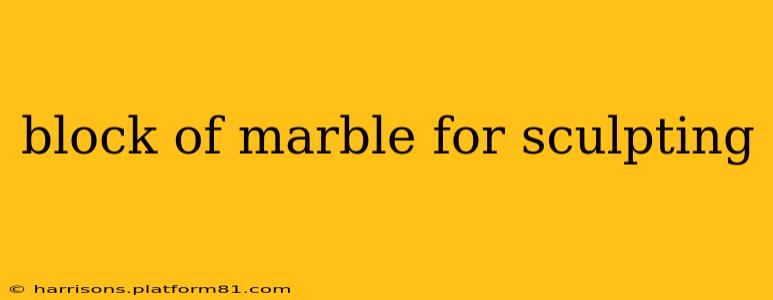Marble, with its timeless beauty and versatility, has been the favored medium for sculptors for millennia. Selecting the right block, however, is crucial for a successful project. This guide explores the essential considerations when choosing a block of marble for sculpting, ensuring you find the perfect piece to bring your artistic vision to life.
What are the different types of marble used for sculpting?
Marble isn't a single material; it's a metamorphic rock with diverse variations in color, veining, and hardness. Popular choices for sculpting include:
-
Carrara Marble (Italy): Renowned for its pure white color and fine grain, it's prized for its ability to hold detail and its luminous quality. Michelangelo famously used Carrara marble for many of his masterpieces. Variations exist within Carrara marble, ranging from pure white to subtly veined.
-
Paros Marble (Greece): Historically significant, Paros marble boasts a bright white color with minimal veining, making it ideal for sculptures requiring clean lines and delicate detail.
-
Statuary Marble: This isn't a specific type of marble but rather a classification based on the stone's suitability for sculpting. Statuary marbles generally feature a fine grain, even texture, and a light color, allowing for intricate detailing. Many marbles, including Carrara and Paros, fall under this category.
-
Other Marbles: A wide variety of other marbles are available globally, each with unique characteristics in color, veining, and hardness. These include colored marbles (e.g., verde antico, rosso antico) that offer dramatic visual effects. The choice depends entirely on the desired aesthetic for the sculpture.
What factors should I consider when choosing a block of marble?
Several factors influence the selection of a marble block for sculpting:
-
Color and Veining: The color and veining pattern significantly impact the final aesthetic of the sculpture. Consider how these elements contribute to the overall design and artistic expression. Do you desire a clean, unblemished surface or a piece with striking veining?
-
Grain Size and Texture: Fine-grained marble is generally preferred for detailed work as it allows for finer carving. Coarse-grained marble is more challenging to work with but can offer a unique textural effect.
-
Hardness and Durability: The hardness of the marble affects its workability and the tools required for sculpting. Harder marbles are more resistant to chipping and damage but require more effort to carve.
-
Size and Shape: The size and shape of the block should be appropriate for the intended sculpture. Consider the scale of your project and the amount of material needed to create the desired form. A larger block offers more flexibility but also presents greater challenges during the sculpting process.
-
Budget: Marble prices vary significantly based on type, quality, and size. Set a realistic budget before beginning your search to avoid unexpected costs.
How can I find a reputable supplier of marble for sculpting?
Finding a reputable supplier is crucial to ensure the quality and authenticity of your marble. Look for suppliers with a long history of providing marble to sculptors, and ideally, visit their facilities if possible to inspect the blocks in person. Read reviews and testimonials from other artists to assess their reputation and customer service.
What is the best type of marble for beginners?
For beginners, a fine-grained, relatively softer marble like a well-vetted Carrara marble is often recommended. Its workability allows for easier learning and less frustration during the initial stages of sculpting.
How much does a block of marble for sculpting cost?
The cost of a marble block varies dramatically depending on the type, size, quality, and supplier. Small blocks of less expensive marbles may cost a few hundred dollars, while larger blocks of high-quality Carrara marble can cost thousands. It's essential to obtain quotes from multiple suppliers before making a purchase.
Where can I find marble blocks for sale?
Marble blocks are available through various sources, including specialized stone suppliers, quarries, and online marketplaces. Thorough research is essential to ensure you're working with a reputable provider.
By carefully considering these factors, you can select the perfect block of marble to bring your sculptural vision to life. Remember that the choice of marble is a significant artistic decision that directly influences the final outcome of your work. Happy sculpting!
